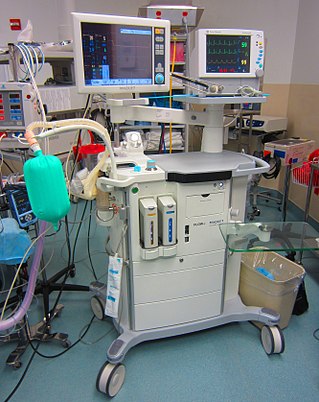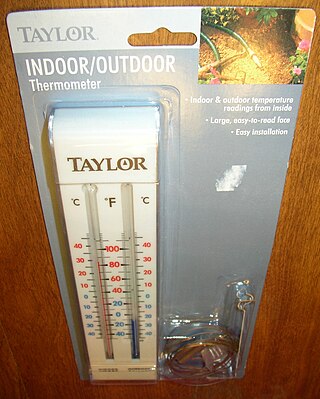
Daniel Gabriel Fahrenheit FRS was a physicist, inventor, and scientific instrument maker, born in Poland to a family of German extraction. Fahrenheit invented thermometers accurate and consistent enough to allow the comparison of temperature measurements between different observers using different instruments. Fahrenheit is also credited with inventing mercury-in-glass thermometers more accurate and superior to spirit-filled thermometers at the time. The popularity of his thermometers led to the widespread adoption of his Fahrenheit scale attached to his instruments.

A thermocouple, also known as a "thermoelectrical thermometer", is an electrical device consisting of two dissimilar electrical conductors forming an electrical junction. A thermocouple produces a temperature-dependent voltage as a result of the Seebeck effect, and this voltage can be interpreted to measure temperature. Thermocouples are widely used as temperature sensors.

A thermistor is a semiconductor type of resistor whose resistance is strongly dependent on temperature, more so than in standard resistors. The word thermistor is a portmanteau of thermal and resistor.

A thermometer is a device that measures temperature or temperature gradient. A thermometer has two important elements: (1) a temperature sensor in which some change occurs with a change in temperature; and (2) some means of converting this change into a numerical value. Thermometers are widely used in technology and industry to monitor processes, in meteorology, in medicine, and in scientific research.
This is a timeline of temperature and pressure measurement technology or the history of temperature measurement and pressure measurement technology.

The mercury-in-glass or mercury thermometer is a thermometer that uses the thermal expansion and contraction of liquid mercury to indicate the temperature.

A hygrometer is an instrument which measures the humidity of air or some other gas: that is, how much of it is water vapor. Humidity measurement instruments usually rely on measurements of some other quantities such as temperature, pressure, mass, and mechanical or electrical changes in a substance as moisture is absorbed. By calibration and calculation, these measured quantities can be used to indicate the humidity. Modern electronic devices use the temperature of condensation, or they sense changes in electrical capacitance or resistance.
Resistance thermometers, also called resistance temperature detectors (RTDs), are sensors used to measure temperature. Many RTD elements consist of a length of fine wire wrapped around a heat-resistant ceramic or glass core but other constructions are also used. The RTD wire is a pure material, typically platinum (Pt), nickel (Ni), or copper (Cu). The material has an accurate resistance/temperature relationship which is used to provide an indication of temperature. As RTD elements are fragile, they are often housed in protective probes.

Vital signs are a group of the four to six most crucial medical signs that indicate the status of the body's vital (life-sustaining) functions. These measurements are taken to help assess the general physical health of a person, give clues to possible diseases, and show progress toward recovery. The normal ranges for a person's vital signs vary with age, weight, sex, and overall health.

Temperature measurement describes the process of measuring a current temperature for immediate or later evaluation. Datasets consisting of repeated standardized measurements can be used to assess temperature trends.

An infrared thermometer is a thermometer which infers temperature from a portion of the thermal radiation sometimes called black-body radiation emitted by the object being measured. They are sometimes called laser thermometers as a laser is used to help aim the thermometer, or non-contact thermometers or temperature guns, to describe the device's ability to measure temperature from a distance. By knowing the amount of infrared energy emitted by the object and its emissivity, the object's temperature can often be determined within a certain range of its actual temperature. Infrared thermometers are a subset of devices known as "thermal radiation thermometers".

Hugh Longbourne Callendar was a British physicist known for his contributions to the areas of thermometry and thermodynamics.
Normal human body temperature is the typical temperature range found in humans. The normal human body temperature range is typically stated as 36.5–37.5 °C (97.7–99.5 °F).
Exergen Corporation is a designer and manufacturer of infrared scanners, thermometers, and sensors headquartered in Watertown, Massachusetts. Exergen's products are used in application in medical, automotive, food processing, agriculture and textile. The company was founded by Francesco Pompei in 1980.

The alcohol thermometer or spirit thermometer has a similar construction and theory of operation as a mercury-in-glass thermometer. However, the thermometric fluid of an alcohol thermometer is less toxic and evaporates quickly making it a safer alternative to mercury thermometers. The ethanol version is the most widely used due to the low cost and relatively low hazard posed by the liquid in case of breakage.
A Beckmann thermometer is a device used to measure small differences of temperature, but not absolute temperature values. It was invented by Ernst Otto Beckmann, a German chemist, for his measurements of colligative properties in 1905. Today its use has largely been superseded by platinum PT100 resistance thermometers and thermocouples.

An indoor–outdoor thermometer is a thermometer that simultaneously provides a measurement of the indoor and outdoor temperatures. The outdoor part of the thermometer requires some kind of remote temperature sensing device. Conventionally, this was done by extending the bulb of the thermometer to the remote site. Modern instruments are more likely to use some form of electronic transducer.

Rectal thermometry is taking a person's temperature by inserting a thermometer into the rectum via the anus. This is generally regarded as the most accurate means of temperature-taking, but some may consider it to be an invasive or humiliating procedure. Thus, it is often used sparingly and primarily on infants, children, or adults for whom taking an oral temperature would risk injury or be inaccurate.















